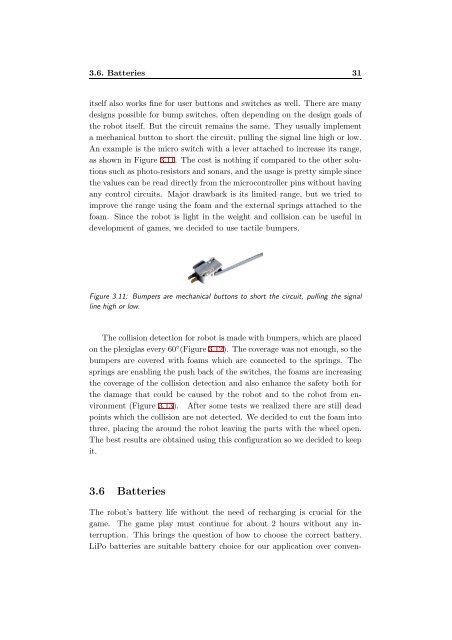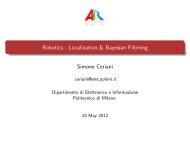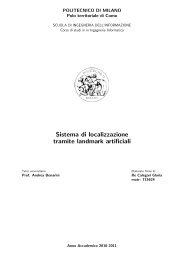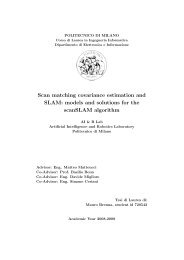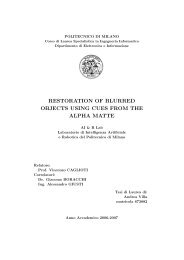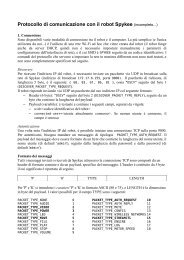Submitted version of the thesis - Airlab, the Artificial Intelligence ...
Submitted version of the thesis - Airlab, the Artificial Intelligence ...
Submitted version of the thesis - Airlab, the Artificial Intelligence ...
You also want an ePaper? Increase the reach of your titles
YUMPU automatically turns print PDFs into web optimized ePapers that Google loves.
3.6. Batteries 31<br />
itself also works fine for user buttons and switches as well. There are many<br />
designs possible for bump switches, <strong>of</strong>ten depending on <strong>the</strong> design goals <strong>of</strong><br />
<strong>the</strong> robot itself. But <strong>the</strong> circuit remains <strong>the</strong> same. They usually implement<br />
a mechanical button to short <strong>the</strong> circuit, pulling <strong>the</strong> signal line high or low.<br />
An example is <strong>the</strong> micro switch with a lever attached to increase its range,<br />
as shown in Figure 3.11. The cost is nothing if compared to <strong>the</strong> o<strong>the</strong>r solutions<br />
such as photo-resistors and sonars, and <strong>the</strong> usage is pretty simple since<br />
<strong>the</strong> values can be read directly from <strong>the</strong> microcontroller pins without having<br />
any control circuits. Major drawback is its limited range, but we tried to<br />
improve <strong>the</strong> range using <strong>the</strong> foam and <strong>the</strong> external springs attached to <strong>the</strong><br />
foam. Since <strong>the</strong> robot is light in <strong>the</strong> weight and collision can be useful in<br />
development <strong>of</strong> games, we decided to use tactile bumpers.<br />
Figure 3.11: Bumpers are mechanical buttons to short <strong>the</strong> circuit, pulling <strong>the</strong> signal<br />
line high or low.<br />
The collision detection for robot is made with bumpers, which are placed<br />
on<strong>the</strong>plexiglas every 60 ◦ (Figure3.12). Thecoverage was not enough, so<strong>the</strong><br />
bumpers are covered with foams which are connected to <strong>the</strong> springs. The<br />
springs are enabling <strong>the</strong> push back <strong>of</strong> <strong>the</strong> switches, <strong>the</strong> foams are increasing<br />
<strong>the</strong> coverage <strong>of</strong> <strong>the</strong> collision detection and also enhance <strong>the</strong> safety both for<br />
<strong>the</strong> damage that could be caused by <strong>the</strong> robot and to <strong>the</strong> robot from environment<br />
(Figure 3.13). After some tests we realized <strong>the</strong>re are still dead<br />
points which <strong>the</strong> collision are not detected. We decided to cut <strong>the</strong> foam into<br />
three, placing <strong>the</strong> around <strong>the</strong> robot leaving <strong>the</strong> parts with <strong>the</strong> wheel open.<br />
The best results are obtained using this configuration so we decided to keep<br />
it.<br />
3.6 Batteries<br />
The robot’s battery life without <strong>the</strong> need <strong>of</strong> recharging is crucial for <strong>the</strong><br />
game. The game play must continue for about 2 hours without any interruption.<br />
This brings <strong>the</strong> question <strong>of</strong> how to choose <strong>the</strong> correct battery.<br />
LiPo batteries are suitable battery choice for our application over conven-


